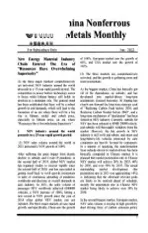China’s Copper Fabricating Industry Need of Consolidation,Restructuring and Upgrading
2011-08-15
“During the 11th Five-Year Plan period,China’s copper processing industry advanced by leaps and bounds, nevertheless it still lagged far behind international standards. The industry was plagued by low industrial concentration,fierce competition of similar mid/low-end products and lack of high-speed and highprecision processing equipment and technologies. China’s copper processing industry still has a long way to go before turning itself from‘big’ to ‘powerful’”. Wen Xianjun, Vice Chairman of China Nonferrous Metals Industry Association said when attending “China Nonferrous Metals Processing Equipment & Technologies Forum 2011”.
It is reported that, China’s copper output reached 10,092,700 tons in 2010, up by 13.6%on a y-on-y basis, hitting a new high, ranking No.1 in the world for a eighth year and accounting for more than half of the total output of the world.
Wang Biwen, Director of China Nonferrous Metals Fabrication Industry Association Copper Office said, during the 11th Five-Year Plan period, China’s copper industry had experienced tremendous changes from traditional copper products to modern copper products in the directions of high precision, high performance, environmental protection and energy conservation, and the overall technical level has been greatly enhanced.
“The rapid growth of product output can not only meet the requirement of development of national economy, but also lay a solid foundation for structural adjustment and industrial upgrade of China’s copper industry in the 12th Five-Year Plan period”, Wen said. As copper product output grows rapidly, the copper processing industry faces increasingly intense competition. Wang noted that, China’s copper processing industry had experienced tremendous changes in the recent 10 years, and its production capacity ballooned. According to incomplete statistics of China Nonferrous Metals Fabrication Industry Association, at present,China’s new capacity for production of copper plate & strip stands at approximately 1,200,000 tons, that of copper tube and rod stands at 450,000 tons, that of copper wire rod and copper wire stands at 1,500,000 tons, and the copper processing capacity will increase by 3,150,000 tons in total, all of which will be completed by 2015, and production capacity release will undoubtedly intensify the market competition. Moreover, impact of the global financial crisis on the copper processing industry still lingers, and recession of the global copper market has not improved fundamentally.Wang noted in his speech that, in the wake of the financial crisis, Chinese copper processing enterprises have to face a pervasive problem of market shrinkage and their profits dropped. In order to cope with the economic crisis, China has adopted a series of effective measures with the main aim of boosting domestic demand. In 2009, China’s copper market began to recover,but the international market did not improve fundamentally. In the same year, China’s copper export declined across the board, indicating that the global market was experiencing a slow recovery. Especially, in 2010, all countries were concerned about inflation, casting a shadow over the hope for prosperity of the global copper market. Shrinkage of the global copper market compelled Chinese copper manufacturers to concentrate on the domestic market.
In addition, Chinese copper enterprises have to compete with copper companies of developed countries, which have been occupying our domestic market in virtue of their advantages in technologies, equipment and sophisticated products. The above fact added fuel to the already-intense competition. Meanwhile, fluctuating metal price will also have a great impact on the copper industry. According to Wang,price of raw material of copper accounts for approximately 85%-90% of copper price, therefore, copper price fluctuation tends to greatly affect copper processing enterprises. On one hand, it gives rise to dramatic change of current funds; on the other hand, it results in changes of the relationship between supply and demand.Therefore, it is very important for copper processing enterprises to accurately predict copper price changes and adapt to drastic fluctuation of copper price. Wang considered that sufficient supply of copper will have an impact on copper price in 2010, and if everything goes well, copper price will decline steadily. However, as copper raw materials are destocked,copper price will eventually rise and remain high.
On one hand, the industrial competition is heating up; on the other hand, China’s copper processing industry is still plagued by many problems of its own development. Compared with developed countries, China is still troubled by the problems of “big but not strong” and “excessive but not good”, etc. “China has many small copper processing enterprises, which are in dire need of consolidation, merger and restructuring due to low industrial concentration.” Wang said so.
According to incomplete statistics, China has 1,200 copper manufacturers with average size of no greater than 10,000 tons, and only 8 enterprises with their output greater than 100,000 tons.
In addition, China has to face the problems of coexistence of advanced and backward copper processing technologies and equipments, imbalance of copper varieties and quality, overcapacity of bulk commodities, under-capacity of high-end product and dependence on import of certain products, which indicates that it is urgent to improve related technologies, equipment and product quality of the copper processing industry.
杂志排行
China Nonferrous Metals Monthly的其它文章
- CPI Challenges CHINALCO in Aluminum Business
- CISRI Competes for Light Rare Earth in North China
- China’s Titanium Gained Great Support Both Nationally and Locally
- The Phase I of Henan Sanfeng Copper Has Completed Construction
- Kunpeng Copper: The largest Copper Smelting Company of Sichuan
- China’s Source Countries of Copper Concentrate Likely to Change
